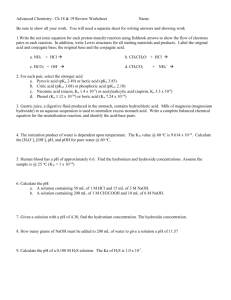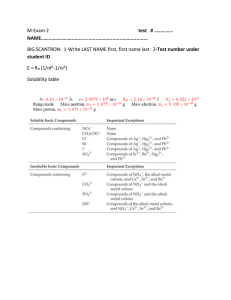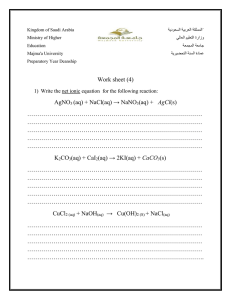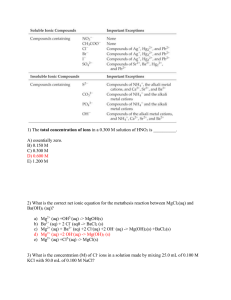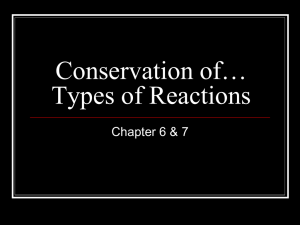ACIDS & BASES
advertisement
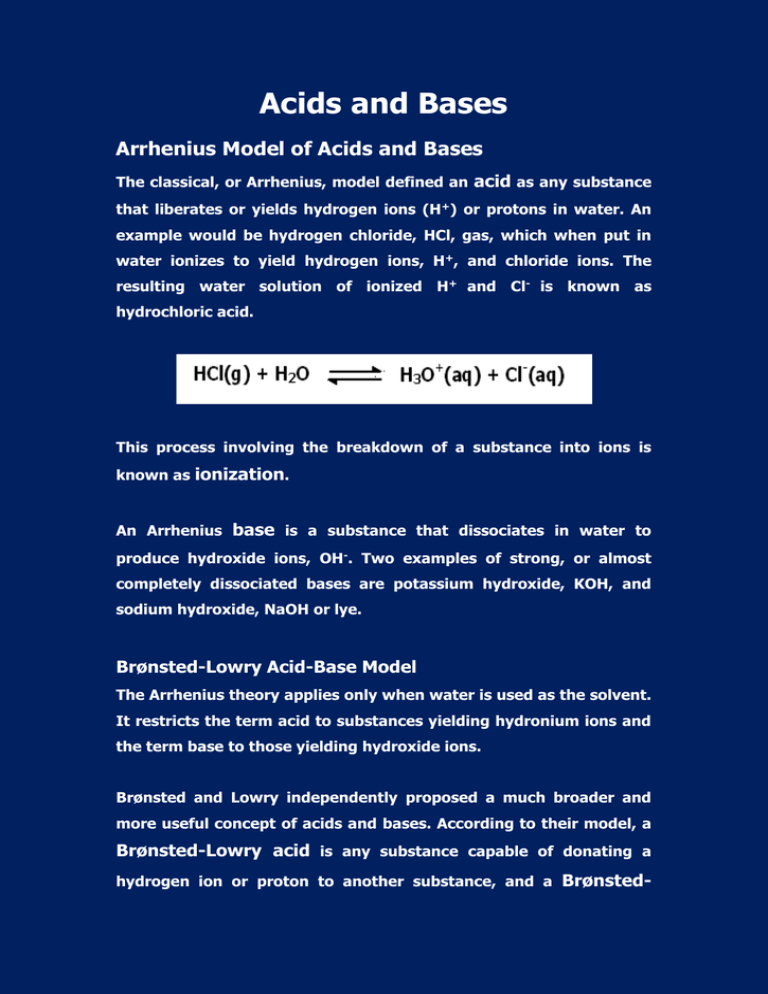
Acids and Bases Arrhenius Model of Acids and Bases The classical, or Arrhenius, model defined an acid as any substance that liberates or yields hydrogen ions (H+) or protons in water. An example would be hydrogen chloride, HCl, gas, which when put in water ionizes to yield hydrogen ions, H+, and chloride ions. The resulting water solution of ionized H+ and Cl- is known as hydrochloric acid. This process involving the breakdown of a substance into ions is known as ionization. An Arrhenius base is a substance that dissociates in water to produce hydroxide ions, OH-. Two examples of strong, or almost completely dissociated bases are potassium hydroxide, KOH, and sodium hydroxide, NaOH or lye. Brønsted-Lowry Acid-Base Model The Arrhenius theory applies only when water is used as the solvent. It restricts the term acid to substances yielding hydronium ions and the term base to those yielding hydroxide ions. Brønsted and Lowry independently proposed a much broader and more useful concept of acids and bases. According to their model, a Brønsted-Lowry acid is any substance capable of donating a hydrogen ion or proton to another substance, and a Brønsted- Lowry base is any substance capable of accepting a proton or hydrogen from another substance. In other words, acids are proton donors, and bases are proton acceptors. According to this concept, any reaction involving the transfer of a proton or H+ from one substance to another is an acid-base reaction. Therefore, base is a proton acceptor and an acid is a proton donor. For example: Notice that water can act as either an acid or as a base. For this reason it is called amphoteric. Some examples of acids and bases Acid HCl = H+ CH3COOH = H+ + CH3COO_ NH4+ = H+ + NH3 H2CO3 = H+ + HCO3- HCO3- = H+ + CO3-- H2O = H+ + OH- H3O+ = H+ + H2O Hydronium ions Conjugate base + Cl- Consider HCl, a gas composed of polar covalent molecules. When HCl gas is passed through water we achieve the classic substance, hydrochloric acid, HCl(aq). The original gas does not have any of the properties of the resulting solution. It is reasonable to assume that molecules of HCl react with the water to produce ions. It is these ions that ultimately give the water and HCl solution it's acidic properties. The reaction above consists of a breaking away of a proton, H+, from the HCl molecules. A stable co-ordinate bond is formed when a proton, H+, shares a pair of electrons with an oxygen atom of the highly polar water molecule. A hydrated proton, called the hydronium ion, H3O+, is formed. Concentrated vs. Dilute; Strong vs. Weak: These terms are often the most misused in chemistry. Concentrated and dilute refer to the concentration of an acidic or basic substance in a solvent. eg. 16 M HCl is more concentrated than a 0.5 M solution of the same acid. Strong and weak refer to the ability of an acid or base to dissociate. A strong acid will dissociate completely in water to form hydronium ions. i.e. 100% of it will form H3O+. A weak acid or base will only dissociate to a certain percentage. Often a very small percentage only. Strong and Weak Bases NH3(aq) is a poor conductor of electricity when compared with NaOH(aq). This means that the degree of dissociation of NH3 in water is relatively small when compared with that of the NaOH. A base which is only slightly dissociated in aqueous solution is called a weak base; one which is highly dissociated is called a strong base. All the strong bases happen to be inorganic, that is, the NaOH, KOH, RbOH group. Even Ca(OH)2 and Ba(OH)2 are considered to be strong bases. All of the rest are too insoluble to provide a significant [OH-] in water. The double arrow convention should be used when dealing with a weak base. A single arrow is to be used when showing the dissociation of a strong base since for all practical purposes, dissociation is 100% complete. i.e., a water solution made from NaOH(s) will have no molecules of NaOH in it. The NaOH will be completely ionized into Na+ and OH-. The pH Scale Every aqueous solution is either acidic, basic or neutral. There is a quantitative relationship between the concentration of hydronium and hydroxide ions in the solution. The pH scale is a numerical scale which, for most applications extends from 0 through to 14. The numbers on the scale represent the relative acidity of solutions and can be converted into actual hydronium ion concentrations. The brackets as usual denote molar concentrations. The pH scale is based on the self-ionization of pure water. Two water molecules will sometimes combine into hydronium and hydroxide ions. Pure water is considered to neutral and the hydronium ion concentration is 1.0 x 10-7 mol/L which is equal to the hydroxide ion concentration. The equilibrium law for this reaction at 25oC should be: You will please note that at neutrality the molarity of the hydronium ion is 10-7. The 7 plays a part in the pH scale by indicating neutrality. The scale reaches a maximum at 14. Please note again that the hydronium and hydroxide concentrations multiply out to 10-14 M. The pH scale was derived around this relationship: So the pH is the -log of the [hydronium ion]. pH [H3O+] [OH-] pOH 1 10-1 10-13 13 2 10-2 10-12 12 3 10-3 10-11 11 4 10-4 10-10 10 5 10-5 10-9 9 6 10-6 10-8 8 7 10-7 10-7 7 8 10-8 10-6 6 9 10-9 10-5 5 10 10-10 10-4 4 11 10-11 10-3 3 12 10-12 10-2 2 13 10-13 10-1 1 The pH of a solution may be determined by the use of an electronic instrument known as a pH meter, or through the use of chemical indicators. Acid-base indicators are dyes which undergo slight changes in molecular structure and color when the pH value of the solution changes. Specific colors correspond to specific pH values. Some examples are: litmus, phenolphthalein, bromothymol blue, etc. There is a list of acid-base indicators in the databook. Sample Problems What is the pH of an HCl solution which has a [H3O+] = 1.0 x 10-3? pH = -log[H3O+] = -log[1.0 x 10-3] = -(-3) = 3 What is the pH of an acetic acid solution whose [H3O+]=2.5 x 10-4? What is the hydronium concentration of nitric acid if the pH=4.0? [H3O+] = 10-pH = 10-(4) = 1.0 x 10-4 mol/L What is the [H3O+] of HCl if the pH = 2.57? What is the pH of 0.010 mol/L hydrochloric acid? The pOH Scale The pOH scale is the corollary of the pH scale ie. pH + pOH = 14 You'll remember from math class that when you multiply two numbers you only add their logs. [H3O+]*[OH-] = (1.0 x 10-7 )*(1.0 x 10-7) = 1.0 x 10-14 or -log[H3O+] + -log[OH-] = 7 + 7 = 14 Thus a solution that has a pH = 7 must also have a pOH = 7. Problems What is the pOH of a 0.010 mol/L NaOH solution? What is it's pH? 2- What are the hydronium ion and hydroxide ion concentration of a solution prepared by adding 1 mL of 1.0 mol/L HCl to 9 mL of water? Assume that volumes are additive and that the 1 mol/L HCl dissociates completely. 3- What are the hydronium ion and hydroxide ion concentrations of a solution made by adding 1 mL of 0.1 mol/L NaOH to 9 mL of water? 4- Find the pH, pOH, [OH-] of a 0.00010 mol/L HCl solution. 5- Find the pH of a 0.00325 mol/L NaOH solution. 6- What is the hydronium ion concentration of a solution that has a pH = 2.6? Dissociation of water: From conductivity measurements, water has been shown to be very weakly ionized and at 25°C the concentration of hydrogen ions is only 10-7 gram equivalents per liter. The equilibrium constant for the dissociation of water is given by: or Now the concentration of water to all intents and purposes is constant, so we can write: The ionic product of water at 25°C is, therefore, At neutrality the pH of pure water at 25°C is 7 At other temperatures, the pH at neutrality is not 7 since K w varies with temperature. Even a small change in temp from 37 to 40°C causes an 8% increase in hydrogen and hydroxyl ions so that a slight rise or fall in temp may produce a profound biological change in a living system sensitive to hydrogen ion concentration. Temperature [°C] pH of neutrality 0 7.97 25 7.00 37 6.80 40 6.77 75 6.39 100 6.16 Measurement of pH: The most convenient and reliable method for measuring pH is by the use of a pH meter. This instrument measures the EMF of a concentration cell using a reference electrode (Calomel reference electrode) and a glass electrode reverseble to hydrogen ions. The usual type of cell employed is shown below: Glass electrode is very sensitive to pH change. The glass electrode rapidly responds to hydrogen ion concentration and can be used in a wide variety of media. The electrode must be always be thoroughly washed after use and stored in distilled water. Standard pH solutions: The pH meter is calibrated before use by means of a standard solution. In the United Kingdom, potassium hydrogen phthalate is the recommended standard; at 15°C a 0.05 M solution has a pH of 4.000. The pH at other temperatures (0 – 60°C) can be obtained from the equation: pH = 4.000 + ½ ( t-15 / 100)2 The meter should be calibrated with a solution whose pH is close to that under test and several convenient standards are given below. Primary standards for the calibration of a pH meter Dissociation of acids and bases Strong acids: They are completely dissociated to hydrogen ions and the conjugate base occurs, so that the hydrogen ion concentration is the same as that of the acid. The pH can therefore, be very easily calculated: In a solution of 0.01 N HCl, H concentration = HCl concentration = 0.01 N = 10-2 N pH = -log [10-2] = 2 Strong basis: They are also completely dissociated . In a solution of 0.01 N NaOH, OH concentration = 0.01 N = 10-2 N pOH = -log [OH-] pOH = -log [10-2] = 2 pH = pKw – pOH pH = 14 – pOH = 14- 2 = 12 NaOH concentration = Weak acids: Weak acids are only slightly ionized in solution and a true ewquilibrium is established between the acid and the conjugate base. If HA represents a weak acid, HA = H+ + A- According to the law of mass action, Ka the acid dissociation constant is defined as: Taking negative logarithms, This formula is known as the Henderson-Hasselbalch equation and is valid over the pH range 4-10 where the hydrogen and hydroxyl ions do not contribute significantly to the total ionic concentration. In addition, the ratio of conjugate base to acid should be less than 0.1. pKa is the negative logarithm of the acid dissociation constant of a waek acid Another way of defining pKa is the pH at which the concentrations of the acid and its conjugate base are equal. Buffer Solutions A buffer solution is one that resists pH change on the addition of acid or alkali. Buffer consisted of weak acid + its salt (acetic acid + sodium acetate) or weak base + its salt (ammonium hydroxide + ammonium chlorid). Such solutions are used in many biochemical experiments where the pH needs to be accurately controlled. From the Henderson-Hasselbalch equation, the pH of a buffer solution depends on two factors; one is the pKa value and the other the ratio of salt to acid. Let us take as an example acetate buffers consisting of a mixture of acetic acid and sodium acetate: Since acetic acid is only weakly dissociated, the concentration of acetic acid is almost the same as the amount put in the mixture; likewise the concentration of acetate ion can be considered to be the same as the concentration of sodium acetate placed in the mixture since the salt is completely dissociated. Example: What is the pH of a mixture of 5 ml of 0.1 M sodium acetate and 4 ml of 0.1 M acetic acid. (pKa CH3COOH = 4.76) Solution Example: How is the pH changed on adding 1 ml of 0.1 N HCl to the above mixture. Solution Addition of HCl provides H+ which combines with the acetate ion to give acetic acid. This reduces the amount of acetate ion present and increases the quantity of undissociated acetic acid, leading to an alteration in the salt/acid ratio and hence to a change in pH. Concentration of CH3COO- = (5/10) x 0.1 M - (1/10) x 0.1 M = 0.04 M Concentration of CH3COOH = (4/10) x 0.1 M + (1/10) x 0.1 M = 0.05 M pH = pKa + log10 [salt] / [acid] pH = 4.76 + log10 [0.04] / [0.05] pH = 4.76 + (- 0.097) pH = 4.66 The pH of the solution has been reduced from 4.86 to 4.66, a change of only 0.2 of a unit, whereas if the HCl had been added to distilled water, the pH would be 2. The solution has, therefore, acted as a buffer by resisting pH change on the addition of acid. Titration curves When a strong base is mixed with a solution of acid and the pH recorded, a plot of the base added against pH recorded can be obtained and this is known as a titration curve. Strong acid and a strong base: There is little change in pH value on adding base until complete neutralization when only a slight excess of base causes a large increase in pH. In effect, the strong acid is acting as a buffer solution in resisting change in pH. Example: Suppose 10 ml o.1 N HCl is titrated with 0.1N NaOH 1. Initial pH value: [H+] = 0.1 = 1 x 10-1 g mole/L pH = 1 2. After the addition of 5 ml of 0.1N NaOH: On adding 5 ml of strong base, 5 ml of the HCl solution is neutralized leaving 5 ml of 0.1N HCl in a total volume of 15 ml. Normality of HCl = (5/15) x 0.1 = 3.33 x 10-2 pH = - log10 (3.33 x 10-2) pH = - [log10 3.33 + (-2)] pH = - ( 0.523-2) = 1.48 3. After the addition of 9.9 ml of 0.1N NaOH: On adding 9.9 ml of strong base, 9.9 ml of the HCl solution is neutralized leaving 0.1 ml of 0.1 N HCl in a total volume of 19.9 ml. Normality of HCl = (0.1/19.9) x 0.1 = 5.03 x 10-4 pH = - log10 (5.03 x 10-4) pH = - [log10 5.03 + (-4)] pH = - (0.702 -4) = 3.30 4. After the addition of 10.1 ml of 0.1 N NaOH: On adding 10.1 ml of strong base, all the HCl is neutralized leaving 0.1 ml of 0.1 N NaOH in a total volume of 20.1 ml. Normality of NaOH = (0.1 / 20.1) = 4.98 x 10-4 [OH-] = 4.98 x 10-4 pOH = 3.3 pH = 14-3.3 = 10.70 Determination of pKa pKa values can be obtained from titration data by the following methods: 1. By definition, the pKa value is equal to the pH at which the acid is half titrated. The pKa can, therefore, be obtained from a knowledge of the end point of the titration. 2. The ratio of salt / acid can be calculated from the experimental data and a graph prepared of log10 salt / acid against pH. The intercept on the axis is the pKa value. Lewis Acids and Bases Lewis had suggested in 1916 that two atoms are held together in a chemical bond by sharing a pair of electrons. When each atom contributed one electron to the bond it was called a covalent bond. When both electrons come from one of the atoms it was called a dative covalent bond or coordinate bond. The distinction is not clear-cut as the diagram at the right shows; although the ammonia molecule donates a pair of electrons to the hydrogen ion, the identity of the electrons is lost in the ammonium ion that is formed. Nevertheless, Lewis suggested that an electron-pair donor be classified as a base and an electron-pair acceptor be classified as acid. MO diagram depicting the formation of a dative covalent bond between two atoms The modern definition of a Lewis acid is an atomic or molecular species that has an empty atomic or molecular orbital of low energy (LUMO) that can accommodate a pair of electrons, as illustrated in the molecular orbital diagram at the right.
